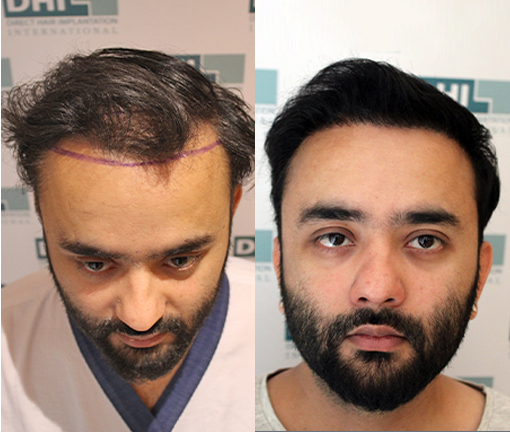Importance of hair line design in DHI Hair Transplant Procedure

Most people notice the first sign of hair loss near their hairline area. And fortunately, the advanced and latest technology in the hair transplant world has made it possible to get restored. Hair transplant surgeons have become more efficient in delivering natural hairline design and transplanting follicular grafts depending on the area’s coverage requirements. The hairline design in DHI Hair Transplant is the most preferred surgery among men and women.
Like the artists, hair transplant surgeons draw a hairline design for men and women. Like a painting, the finest artist and precise paintbrush are required to maintain the best results. And the one with the best knowledge and tools can offer the best texture and density of the hairline. DHI India has a team of expert surgeons who use patent tools to get the proper angle, direction, and depth during the implantation and transplantation process and give you a perfect hairline.
Here, in detail, let’s discuss the principles and importance of hairline design in DHI Hair Transplant
What do you mean by Extended Hairline Region?
The Extended Hairline Region lies in the front portion of the scalp, i.e., 2-3cm in width, that bridges the bald forehead area and decides central density. The front line or anterior border for hairline designing is called a transition zone. The transition zone is a preferred area by surgeons for designing a hairline. The entire Extended Hairline Region is taken into account for artistic hairline design.
The Extended Hairline is important to give a person a dense and natural appearance. For designing a hairline in DHI hair transplant anything between 600-900 hair grafts may be required, and 20-30 follicular units should be placed in every centimeter square in a total of 30-centimeter square space. At DHI this number is finalized by post-detailed examination of the scalp and may vary in different patients based on the individual’s requirement.
The Extended hairline zone comprises:
- Transition Zone: The Transition Zone has a soft and irregular pattern, comprising 0.5-1cm of hairline starting from the forehead. To achieve a natural look in the Transition Zone, the natural hairline should be observed very minutely to judge various elements of it.
- Defined Zone: The Defined Zone has a more defined and denser look, and it comprises of 2-3cm width behind the transition zone. Thicker grafts should be arranged closely to give a natural look in a Defined Zone.
- Frontal Tuft: Frontal Tuft has more definition and comprises the oval area between the transition and defined zone. It is a crucial part of the hairline design because it is at eye level.
Natural hair design can only be achieved by having proper knowledge of the essential area of frontal hairline designing. The expert surgeons at DHI India are certified and trained to perform hair transplants and specialize in this field. At DHI Medical Group, we can design a Frontal Temporal Hairline for men and women with best-in-the-world technology and precision of artistic skills.
7 Things to consider for a perfect hairline:
Experts should perform natural frontal hairline design to get the best results. And a few things should be considered when looking for a perfect hairline. DHI India has combined some important points that define the best hairline design:
1. The use of an ample number of follicular hair units in the extended hairline region can offer the best natural and dense look. The hair transplant should offer high density in the hairline region to look more natural and denser, and that could only be achieved when an adequate number of follicular graft units are involved in the surgery. Depending on the different zones of the extended hairline region, the surgeon should consider density and position.
2. The use of follicular units instead of small slit mini grafts can offer better results. All hairline parts require a dense and high-definition look; therefore, multiple thick grafts should be used in the process. The surgeon should not slit a graft into small mini grafts as it could never offer you the best density. At DHI we make sure that none of the grafts are split, giving the best possible results.
3. The ‘Follicles Pairing’ can offer better results. Follicles Pairing is an important step to implant a desirable number of single follicles, where pairing in the same similar graft collection is done. Here, all the follicular grafts are paired based on their size, hue, and other circumstances.
4. The lateral border in the hairline and frontal-temporal hairline triangle should be your main focus during the hairline design process. The hairline, usually in the case of male pattern hairline designing, the frontal-temporal hairline triangle is on the lateral side.
The base of this triangle lies at the forehead side, where the actual hairline recedes and deepens the look. Also, this is the first thing others notice in your appearance because they occur to be in the present. So, lateral borders in the hairline and the frontal-temporal hairline triangle should be designed properly, accompanied by outlining and then transplanting grafts into that location.
5. The follicular units should be properly transplanted on the anterior border of the hairline. The best hairline design is where the transplanted hair doesn’t appear too low on the forehead. It should be done in the right size and shape for the alopecia. So, the follicular units should be properly transplanted to give a realistic hairline look.
6. The proper angulations and direction will offer a natural outline during the process. To offer the best results from hairline designing, the surgeon should have proper control of angle, depth, and direction. It can only be attained with the skill of the surgeons and the tools they use.
7. The separation and distribution of follicular grafts are important. Depending on the location of the hairline, the separation and distribution of follicular grafts should occur. The surgeon should have different containers for every part of the hairline area and distribute the grafts accordingly in each container.
DHI India follows a step-by-step framework to design hairlines for women and men. DHI Specialists first draw a hairline design, make initial incisions based on the drawing of transition zones, and prepare markings at the frontal-temporal area. After marking is done, the incisions are made in the defined zone. Once the whole framework is ready, the hair transplant of the hair takes place based on the requirement of each location. At last, the stick-and-place method is followed to give your hairline a natural look.
If you are looking for Front Hairline Designing treatment in India, book your consultation with DHI India now.
